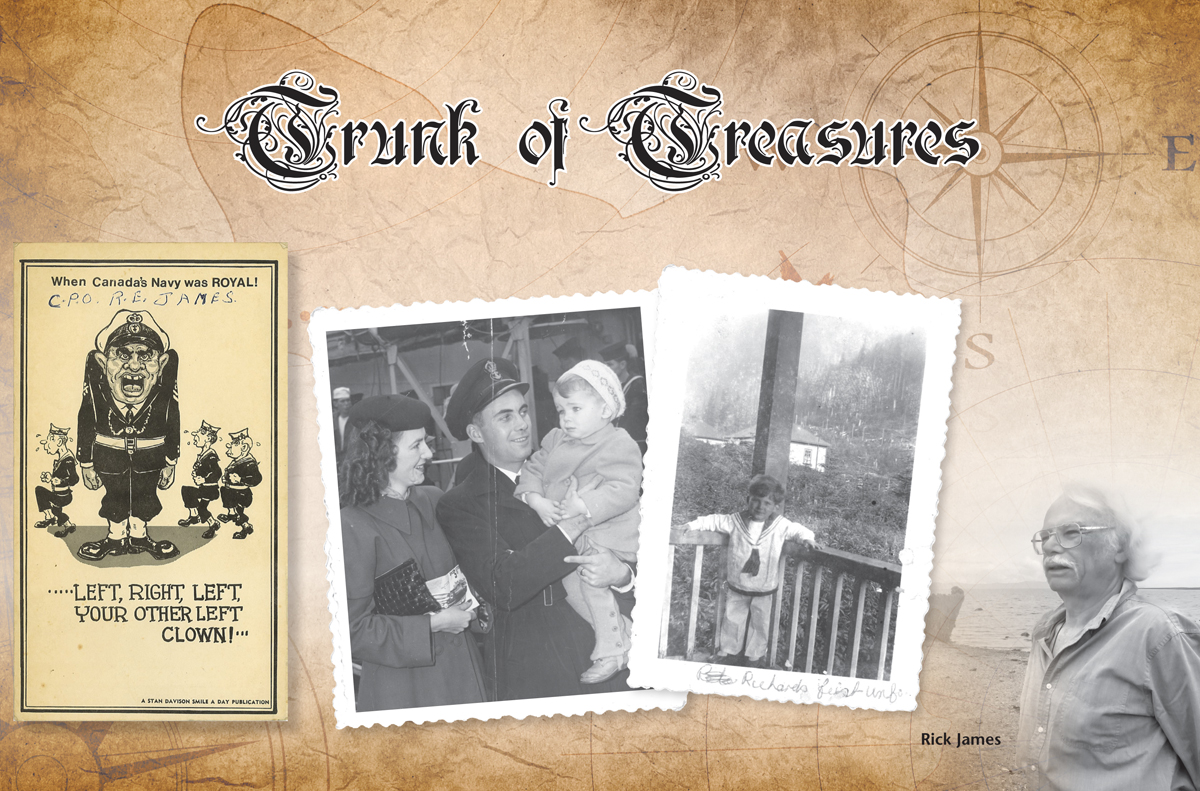Trunk of Treasures
By Lookout on Jun 12, 2020 with Comments 2
Peter Mallett, Staff Writer ~
An old trunk belonging to a deceased navy chief who served during the Battle of Atlantic and in the Cold War era has been donated to the base.
The contents give a glimpse of a bygone era chronicled through an old uniform and hand-written notes by Chief Petty Officer First Class Edward ‘Dick’ James, who was born in the Shetland Islands in 1923 and served the Royal Canadian Navy from 1940 to 1961.
His name and military identification number, 3881-E, are stencilled on the navy blue trunk, travel worn with dings and pockmarks.
“It is not only the contents inside the trunk, but this giant and cumbersome steamer trunk is itself an artefact of how people got around way back when,” said Rick James, son of Chief James and donor of the trunk.
Following the death of his father in 1990, the family took possession of the trunk and overtime reviewed the contents. James has kept a ship’s bell with a small anchor attached and shell casings from bullets his father fired on artillery ranges. But he was compelled to donate the trunk to the base because of its historical value.
“One of the most destructive elements is leaving important stuff that you think is unimportant for only your own immediate family to enjoy. I constantly hear stories about families of mariners throwing out items including journals and notebooks. No, no, if you think it might be important, get it to a museum.”
The trunk’s owner
Dick James became an Ordinary Seaman in March 1941 and was first assigned to CFB Esquimalt-based armed yacht HMCS Cougar and later minesweeper HMCS Outarde, where he became Coxswain. In 1943, he joined the crew of River-Class frigate HMCS Beacon Hill, which would become part of an all-Canadian convoy Escort Group based out of Londonderry, Northern Ireland.
After the war, he served in C-Class destroyer HMCS Crescent, which was sent to China in 1949 to safeguard Canadian interests during the Chinese Civil War. It was the first operational deployment of a Canadian warship since the end of the Second World War.
In subsequent years he became Parade Instructor at the navy’s post-war training base CFB Cornwallis, and a Chief Gunner’s Mate aboard HMCS Cayuga for post-Korean-war patrols and destroyer HMCS Assiniboine. His final post was as Equipment and Trials Officer, Chief Gunnery West Coast before his retirement.
Following his 21-year naval career, James became a successful local real-estate agent, from which he finally retired in the mid-1980s. He passed away in 1990.
Father’s Influence
Son Rick, a prolific author, says his father’s experiences in the military provided the inspiration for much of his writing. On fishing trips his dad would open up about his experiences.
“It was on these trips where I really learned my love of the ocean and developed a connection to maritime history. One of his stories was when he served in the Battle of the Atlantic and was below in the ship’s bunk. He was always on edge and was calmly waiting for what he described as ‘that eventual torpedo in the guts’.”
His writing focuses almost exclusively on Pacific coast maritime history. His latest work Don’t Never Tell Nobody Nothin’ No How: The Real Story of West Coast Rum Running is a detailed look at British Columbia’s rum-running past. He is also the author of B.C. bestseller Raincoast Chronicles 21: West Coast Wrecks and Other Maritime Tales, and has written numerous stories featured in various historical and maritime periodicals, as well as comprehensive reports such as the The Ghost Ships of Royston worked up for the Underwater Archaeology Society of British Columbia.
He was also on History Channel’s Sea Hunters episode, Malahat Queen of the Rum Runners.
His father’s trunk is now at CFB Esquimalt Naval and Military Museum. He hopes it will one day go on display at one of the navy schools because of the many instructor’s handbooks.
To learn more about Rick James and his research and writing about West Coast maritime history, check out: www.rickjamesauthor.ca
––––
Filed Under: Top Stories
About the Author:







Esquimalt
No such thing as CFB Eswuimalt in 1941.